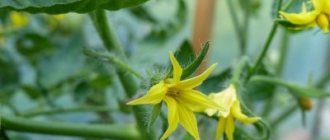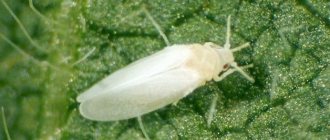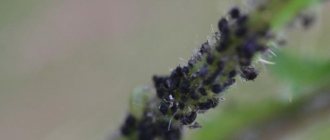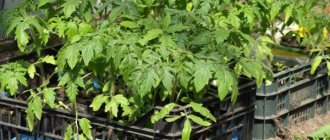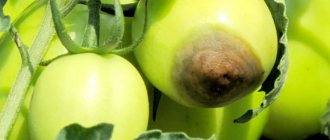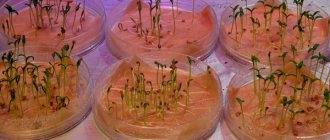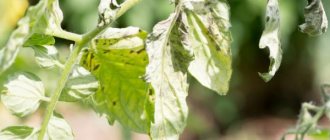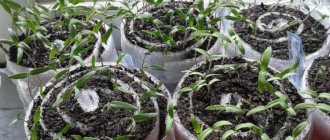Aphids on tomatoes
Physical methods of controlling aphids
Anti-aphid remedies
Chemicals for killing insects
Although tomato tops are one way to control aphids and other pests, the bushes themselves can also be affected. Moreover, most often small insects do not touch the fruits, but settle on tender young leaves, which causes great harm to the plant, sucking out the juices and contributing to the disease and death of a valuable garden crop. Therefore, the story about how to fight aphids on tomatoes will be relevant and useful for many gardeners.
Types of aphids that live on tomatoes
Many people know what aphids look like on garden and vegetable crops. These are small insects 2-3 mm in size that parasitize whole colonies on the underside of leaves and on young shoots of plants. They settle both on greenhouse tomatoes and in open ground, attacking both seedlings and adult bushes.
In the garden you can find different types of these pests: white and black, green, melon and red aphids. There are also insects with and without wings.
The most common types of aphids found on tomatoes are:
- White or root - hatches from eggs overwintering in the ground and settles near the soil surface, which makes it difficult to detect. It moves quickly and gradually chews through the base of plant stems. White aphids that have settled on tomato seedlings can completely block the access to moisture, inhibiting the development of young bushes.
- Potato aphids are red or green insects up to 4 mm in size that attack greenhouse and ground tomatoes.
- Melon aphids are very small pests measuring 1-2 mm in various shades of green. Awakening in the spring and early summer in the greenhouse, the larvae begin to actively develop, gradually become adults, and then fly out into the open air in July-August; winged females are black and green in color.
- Peach (or greenhouse) - overwinters at the bases of the buds of peach trees; during spring reproduction, it often moves to tomatoes and other garden crops.
Aphids on tomatoes
On a note!
A winged aphid is a fertilized female that selects a garden or garden plant, settles on it and, laying eggs, creates a colony of parasites.
Aphids are very often found on tomatoes in a greenhouse, where there are the most favorable conditions of humidity and heat for its development and reproduction. Therefore, any owner who detects even a small amount of such a pest on his seedlings or adult plants needs to choose as quickly as possible how to treat tomatoes against aphids before they cause much damage.
Mistakes of beginner gardeners
Inexperienced gardeners often do not pay attention to signals that there are aphids in the area, and therefore precious time for a quick response is lost, and the pests make their home in the garden.
Signs that precede an aphid invasion:
- Ant activity. Ants are friends of aphids, so if you notice the movement of ants in the beds, it means that aphids will soon appear on the seedlings. What to do? Fight ants.
- Several pests on the branches. This is a signal that they will attract hordes of aphids in a short period of time. Immediately start spraying the plants with what you have at hand: soap solution or ash.
- Rarely weeding the beds. Frequent loosening of the soil is the key to good air circulation between tomato bushes, which is beneficial for plant health. If you grow crops in greenhouses, do not forget to ventilate them more often.
Inspection of plants should be done several times a week, looking under the leaves of the plantings, because this is a favorite breeding place for aphids. The faster you react and apply one of the methods described above, the more effective the measures to destroy aphids will be.
Signs of aphid damage to tomatoes
Signs of damage by small pests on tomatoes and cucumbers:
- leaves, ovaries and young shoots first turn yellow and curl, and then dry out and crumble;
- on the fruits and tops you can see a sticky coating secreted by insects, called sweet honeydew; ants are very fond of it;
- the bushes stop developing and begin to hurt.
Aphids usually do not touch fruits that have already set on adult plants, but young shoots or seedlings can become sick and die, since such insects are also carriers of various infections and viruses. Therefore, the optimal time to get rid of aphids on tomatoes is the period before flowering.
Why are aphids dangerous?
Aphids are dangerous due to their gluttony, omnivorousness and speed of spread. If a midge appears in a room, it quickly moves from vegetables to indoor plants and flowers. Aphids suck the juice from the leaves, and the plant ceases to receive sufficient nutrition. The foliage withers, dries out, and in the absence of treatment, the plants die. Winged small insects are not the first sign. Having noticed flying aphids, you need to immediately and carefully examine the underside of the foliage on tomato seedlings. From here the colony of pests begins to spread.
And if the aphids begin to crawl along the front side of the leaves, it means that the case is already advanced. We begin chemical treatments immediately
Advice It is important to know the parasites in person - it is worth finding photos of larvae and adult aphids on the Internet. The sweet juice from the insect body attracts ants, they quickly spread the aphids throughout the greenhouse and feed on this nectar
Therefore, having noticed paths of ants heading towards the seedlings, we immediately check the lower parts of the foliage and, if aphids are detected, we begin the treatment cycle.
Methods for controlling aphids
Physical methods of controlling aphids Gardeners have accumulated a wealth of experience in combating pests over many years, and most often these methods depend on the growing season and the season when aphids are detected.
In the initial stage of infection, it is recommended to use traditional methods, and in case of severe damage, use insecticidal preparations. Physical methods of struggle:
- You can remove aphids manually by pinching and squashing them between the affected leaves; it is also recommended to use a toothpick.
- It is better to remove green parts that are heavily damaged and deformed, especially the lower shoots and stems.
- The easiest way is to wash off the parasites with a stream of water from a hose or sprayer; it is best to use it daily until the insects are completely gone.
- Predatory insects can significantly reduce the number of aphids on tomatoes: ladybugs, sand wasps and lacewings, as well as birds.
Application of traditional methods
Remedies against aphids
If tomatoes are attacked by aphids, then various folk remedies that can completely destroy the parasites are excellent in the initial stage of infection. All of the following components are available in every household and can be easily prepared at home:
- Composition of 400 g of vegetable oil and 2 tbsp. Spray the tomatoes with 1 liter of tar or laundry soap per 1 liter of water, preferably several times until the insects disappear completely.
- The use of herbal decoctions and tinctures: celandine, wormwood, yarrow and others, which have a bitter taste and a pungent odor. Usually add 1 liter of prepared infusion and 40 g of soap to the bucket for better adhesion.
- An ash-soap solution is prepared from 1 tbsp. ash, 20 g of laundry soap per 10 l.
- Using an infusion of shag or crushed tobacco will help destroy aphids, for which 500 g of powder is poured into 1 liter of boiling water and kept on low heat for 30 minutes, filtered. Before treatment, the solution must be diluted in 10 liters of liquid.
- One of the proven methods is baking soda for aphids in the amount of 75 g of soda per bucket; the mixture can be used to treat both garden crops and fruit trees;
- Ammonia also helps in the fight against aphids, which has an irritating effect not only on their respiratory system with its pungent odor, but also causes a burn to the digestive organs, leading to paralysis and death of insects. To prepare the solution, add 2 tbsp to the bucket. l ammonia and 1 tbsp. l soap or detergent.
Chemicals
It is best to combat aphids with chemicals before the onset of the tomato flowering period, so that harmful substances do not enter the fruits. To do this, you can use various drugs against aphids and other pests:
- Biotlin is a drug that is recommended for use in greenhouses; it destroys adult pests and inhibits the development of aphid larvae. The solution is prepared by adding 5 ml of product per bucket, which will allow you to spray tomatoes over an area of up to 30 square meters. m.
- Spark is an insecticide that will help not only poison aphids and other types of insects, but also feed plants with potassium supplements and anti-stress additives.
- Karbofos is an effective remedy for aphids, it penetrates the insect body through the shell, maintaining a toxic effect for 7-10 days, and has low toxicity for humans.
- Aktara, Tanrek - poison aphids after they eat the green parts of treated plants; treatment of tomatoes against aphids is carried out according to the instructions in a certain dosage; it should be taken into account that the substance can accumulate in the fruits.
- Biological product Fitoverm, which has a wide spectrum of action.
- Chloride of lime - used for spraying the lower part of leaves and stems, has a positive effect on the soil and helps in the fight against not only aphids and other pests, but also diseases of garden crops.
Important!
It is necessary to treat and spray tomatoes against aphids 3 times with a one-week break, since it is during this time that the next generation of pests matures.
Chemicals for killing insects
Prevention of aphids
To prevent an aphid attack from becoming an unexpected surprise, you should take preventive measures in advance to prevent its appearance and reproduction:
- The first stage occurs in the autumn season, when the harvest is carried out. To reduce the number of aphid eggs laid for the winter, it is necessary to collect and destroy all plant remains, and dig up the soil to a depth of 10-15 cm.
- In the spring, in the area allocated for vegetable gardens and tomato plantings, it is recommended to treat with Karbofos to destroy the eggs and larvae of aphids.
- When planting tomatoes, plants with a pungent odor are planted between the rows to repel them: dill, marigolds, celery, etc.
- Throughout the season, regularly inspect the lower parts of the leaves and stems of plants in order to detect in time when white, black or green aphids appear on them, especially in greenhouse plantings.
- In areas near tomato plantings, it is recommended to remove all anthills, the inhabitants of which like to breed aphids for their food.
Pest Information
Aphids attack tomatoes when grown in a greenhouse and in open beds. Seedlings also suffer from this insect.
It is not difficult to recognize the pest on plants. Aphids are small parasites 2–7 mm long. There are several thousand species of this insect. Adults have a proboscis, which they use to pierce the surface of a leaf and extract juice from it.
Aphids emerge from larvae that the insect lays in the fall. In the spring, young individuals emerge from them.
Eggs and larvae overwinter not only on plant remains, but also in the ground. Due to their small size, they are difficult to notice. After birth, the parasite actively reproduces.
Aphids secrete a sugary substance as waste products. This sweet substance attracts ants and other insects, which use it for food.
If there are ants in the area, the risk of aphids increases. Ants accompany it and protect the pest population from other insects.
When aphids appear, it is important to take action in time. Otherwise, it turns into a real disaster for the garden plot. When the pest affects all the plantings, it will be difficult to fight it.
It is important to know! Aphids are dangerous for any vegetable crop in the garden.
